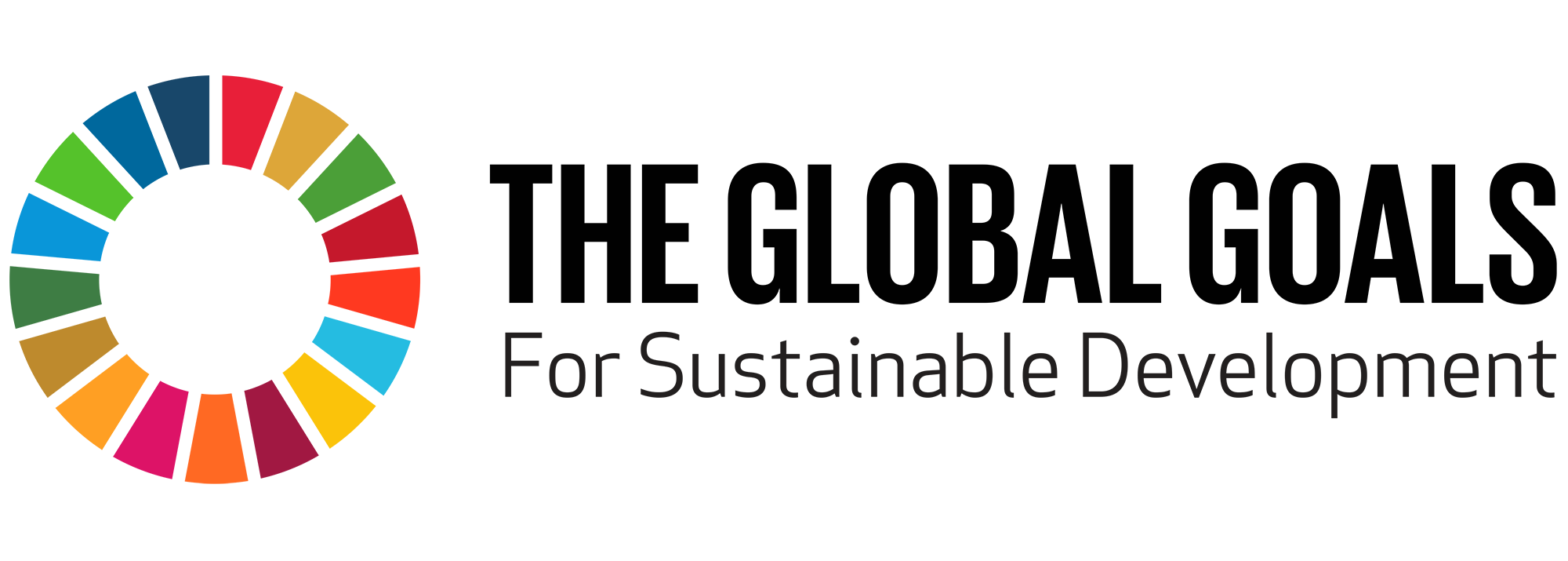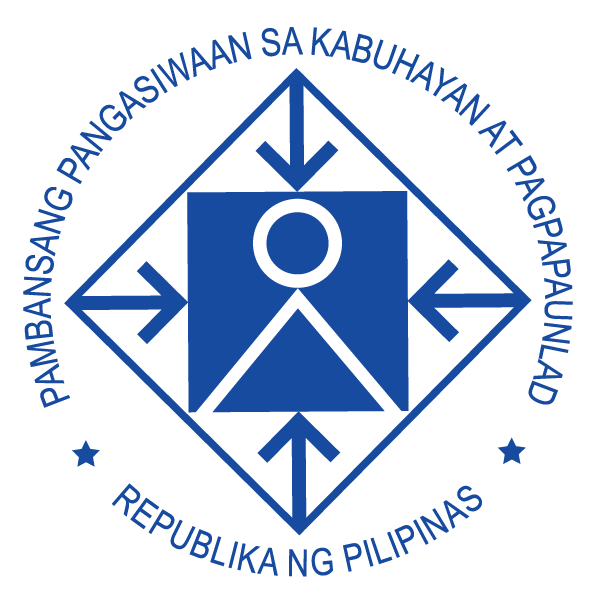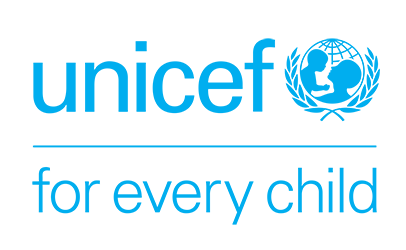The Philippines is an archipelagic country consisting of 17 regions. Despite its geographical structure, provinces and regions exert collective efforts in the attainment of the Sustainable Development Goals in the Philippines.
The National Economic and Development Authority (NEDA), through the its national and regional Sub-Committees on the SDGs, has launched its first open call for best practices in the implementation and localization of the 2030 Agenda for Sustainable Development and its 17 Sustainable Development Goals (SDGs) from late 2021 to early 2022 this year and has received an overwhelming number of programs, activities, or projects (PAPs) coming from different regional line agencies (RLAs), state and local universities and colleges (SUCs and LUCs), and provincial/city/municipal, and local government units (LGUs) representatives, among others, from various sectors across the country.
With the purpose of highlighting examples of best practices, including those that could be replicated or scaled-up especially at a subnational and local level, the following featured SDG best practices include those that are SDG-specific, Results-focused, Inclusive, and Accountable, Sustainable, and Replicable:
See the map below to see an overview of the each region’s best practices, and click the region to view the table with additional details on their respective practices.
Region I
1. Tulong Panghanapbuhay sa ating Disadvantaged/Displaced Workers (TUPAD)/Emergency Employment Program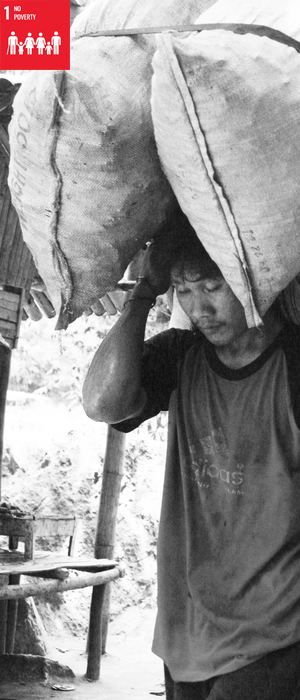
SDG Addressed:
Goal 1 (No Poverty)
– 1.3 Implement social protection systems to the poor
Description: TUPAD is a component of DOLE Integrated Livelihood and Emergency Employment Program (DILEEP). The TUPAD as a COVID-19 Rehabilitation and Recovery program aims to mitigate the economic impact of COVID-19 on the workers in the informal sector, particularly the self- employed with elementary occupations and unpaid family workers. TUPAD provided emergency employment for displaced workers, underemployed and unemployed poor for 10-30 days, depending on the nature of work to be performed. DOLE-RO1 was able to provide emergency employment assistance to 2,876 disadvantaged/underemployed workers with a total amount of assistance of P16,579,532.00 for 2020 to 2021. These beneficiaries were mainly engaged in sanitary and disinfection community projects of the region. Moreover, DOLE-RO1 was able to provide DOLE Integrated Livelihood Projects (DILP), grant assistance for entrepreneurial capacity building to 276 beneficiaries amounting to P3,619,810.00.
2. Regular Conditional Cash Transfer (Pantawid Pamilyang Pilipino Program)
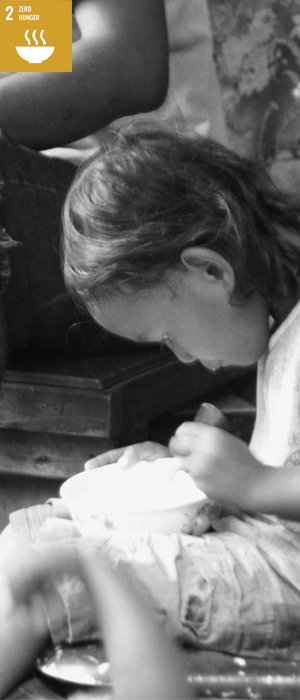 SDG Addressed:
SDG Addressed:
Goal 1 (No Poverty);
Goal 2 (Zero Hunger);
Goal 3 (Good Health and Well-being);
Goal 4 (Quality Education);
Goal 5 (Gender Equality); and
Goal 16 (Peace, Justice and Strong Institution).
Description: 4Ps is a program that has been running in Region 1 since 2008. It aims to alleviate poverty and provide necessary social protection, development, and assistance to the country’s poorest families through cash assistance and other social welfare initiatives. To recognize beneficiaries who are graduating or exiting the program, graduation ceremonies were held in which a total of 5,239 graduating and exiting households attended. 1, 848 of these are considered at the self-sufficient Level of Well-being. This is in addition to the 6,577 household beneficiaries that voluntarily waived from the Program as of December 2021.
To combat hunger, Region 1 initiated the Bio-intensive Gardens to encourage families to build their own backyard garden to ensure daily food security, income generation and prevent malnutrition. To ensure good health and well-being especially during the pandemic, Region 1 formulated Komiks which consist of topics related to general health and nutrition where their understanding was checked through submission of required outputs. To keep children at school, Region 1 formulated modules as part of Youth Development Sessions. A Paralegal Training on Women’s and Children’s Laws for Field Workers Handling Difficult Cases was conducted to equip the 150 Program staff regarding women and children’s laws, legal protocols and referral pathways to strengthen their response to difficult cases.
Region II
1. Project Classhome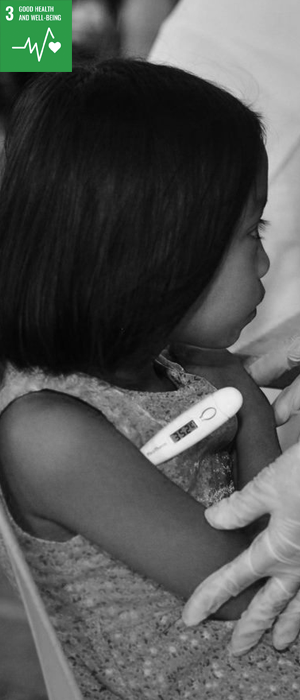
SDG Addressed:
Goal 1 (No Poverty);
Goal 2 (Zero Hunger);
Goal 3 (Good Health and Well-being);
Goal 4 (Quality Education);
Goal 16 (Peace, Justice and Strong Institution); and
Goal 17 (Partnerships for the Goals).
Description: Project Classhome is a Convergence Project that was conceived by the Department of Education-Region 02 in response to the poor living conditions of IPs and the insurgency that infested them for over 50 years now. Since its launching in 2019 with 96 willing Agta and other learners as participants, Project Classhome was able to produce three (3) classhomes (dormitories) to house the learners; a memorandum of agreement with Agta and other IP learners’ parents and elders; a memorandum of agreement with donors/ sponsors of the project and forge partnership with other government organizations or non-government organization; ten (10) GIP teachers who are willing to teach and commit themselves to the program whether as permanent or contract of service were hired with the help of DOLE Region 02. In 2025, the first batch of senior high school graduates will be produced. In the meantime, the success indicator of this project is when all the enrollees will finish a tertiary course or at least senior high and be employed for sustainable way of life and responsible citizenship. The other success factors would be when these Agta and other IP learners are able to practice health and sanitation activities resulting in good hygiene and health, and helping in the school garden for food production.
Region III
 1. Education Policy Development Program
1. Education Policy Development Program
SDG Addressed:
Goal 4 (Quality Education)
Description: As part of the Policy and Research Program, the Education Policy Development Program aims to strengthen evidence-based decision-making through the oversight, promotion, and conduct of policy development, research, and sector monitoring and evaluation. As of mid-year of 2021, the Region has a target of 7 completed research, but has extensively exceeded this. Out of the 264 total proposals, 202 undertakings were completed authored by personnel from the 20 SDOs. This reflects an accomplishment of 2,885.71%.
2. The Technology for Education, Employment, Entrepreneurs, and Economic Development (Tech4ED) Project
SDG Addressed:
Goal 4 (Quality Education)
Description: A Tech4ED Center is a self-sustaining, shared facility providing access to ICT-enabled services and relevant content. It serves as a conduit for efficient delivery of government and other services and a potent tool for the empowerment and participation of the unserved and underserved communities in development. Primary beneficiaries of this project are out-of-school youths and adult, teachers, students, people with disabilities, women, senior citizens, OFWs and their families, entrepreneurs, indigenous people, and farmers and fisherfolks. To date, there are a total of 565 Tech4Ed Centers established within Region III.
3. International Coastal Cleanup Activity
SDG Addressed:
Goal 14 (Life Below Water)
Description: In the implementation of the Integrated Coastal Management (ICM) Program in the Province of Bataan, the Provincial Government and the Bataan Coastal Care Foundation, Inc. have been hosting the annual province-wide coastal cleanup activity since 1999. This activity is also in celebration of the International Coastal Cleanup Day that is conducted every 3rd Saturday of September. Its objectives are to control pollution from land-based activities that threaten Bataan’s coastal and marine environment; mitigate pollution and other damaging activities through integrated approaches and measures to lessen the ecological, economic and social impacts, and sustain the range of values found in Bataan; and cultivate a spirit of volunteerism from different stakeholders. This year, aside from aside from cleaning, the provincial government and DENR Office of Bataan also conducted a webinar entitled “Ocean of Trash and the Coast of Bataan” with the Anvaya Cove Beach and Nature Club gathering a total of 1,170 participants in both the Zoom and Facebook Live.
4. 1 Million Trees for 1 Bataan (1M41B) Challenge
SDG Addressed:
Goal 15 (Life on Land)
Description: In order to curb the detrimental effects of industrialization to the environment and meet the provincial goal of Carbon Neutrality by 2050, 1M41B was conceptualized to empower environmental responsiveness. Some of its targets are to plant 1 million trees in Bataan Province, to encourage every Bataeṅo to plant trees and to promote social and environmental awareness to the community. As of October 2021, the target 1 million trees were already met with a total of 1,046,217 entries from 330 individuals and 266 group participants.
5. Iskolar ng Bataan College Scholarship Program
SDG Addressed:
Goal 4 (Quality Education)
Description: Iskolar ng Bataan Scholarship Program’s goal is to create at least one professional child in every household in the province for productive employment. Since 2005, the program has aided thousands of deserving and talented students enrolled in various State Universities and Colleges nationwide. The Provincial Government of Bataan, through the Sangguniang Panlalawigan, allocates a certain amount of funds from the budget of the Provincial Government of Bataan to sustain the program and activities of the Office of Iskolar ng Bataan. This allocated budget will ensure that all beneficiaries from College Scholarship Program, Gurong Iskolar ng Bataan, Vocational Courses, and Board/Bar Review Financial Assistance will have an equal opportunity to lessen their financial burden and focus on their studies. From its inception and to date, 109,377 deserving scholars have benefitted from the program.
6. Fishfarmers Field School (FFS) on Improved Brackishwater Polyculture using Greenwater Technology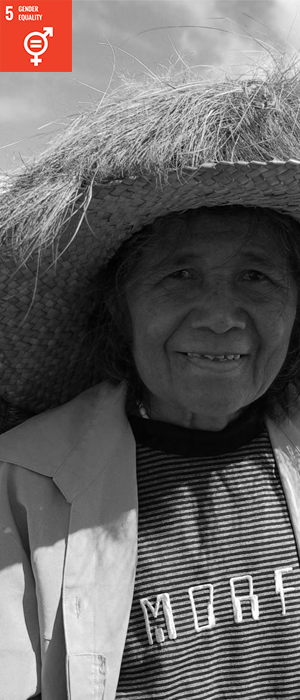
SDG Addressed:
Goal 14 (Life Below Water)
Description: Fishfarmers’ Field School or FFS is a season-long technology training designed to teach fishfarmers the prescribed and step-by-step way of doing a particular farming activity. The FFS, in a way, can be a vehicle in promoting Greenwater Technology. BFAR3 and the Provincial Government of Bulacan, through the Provincial Agriculture Office, and in coordination with the local government unit of Hagonoy will be introducing to the fish farmers the greenwater technology which is believed to answer the long-term sustainability of the shrimp industry. The project started on June 24 and completed on November 19, 2021 at Brgy. Tampok, Hagonoy, Bulacan. In the end of the project period, a 75% adoption rate of the technology, a 15 % increase in yield and a 15 % increase in income were recorded.
7. Tulong Pang-Edukasyon Gabay ng Bagong Henerasyon Scholarship Program
SDG Addressed:
Goal 4 (Quality Education)
Description: This program aims to produce highly qualified graduates and technical experts/specialists who will contribute to the workforce of the province and the country through providing assistance to deserving students in the form of free tuition including miscellaneous fees to local colleges specifically Bulacan Polytechnic College (BPC), living allowance and school supplies and book allowances. For the year 2021, a total of 16,783 individuals benefited from the project where 16,502 of them were already released.
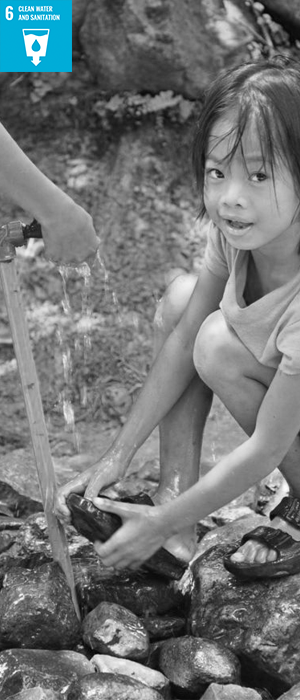 8. The BPC Learning Management System: BPC e-Learning
8. The BPC Learning Management System: BPC e-Learning
SDG Addressed:
Goal 4 (Quality Education)
Description: The Learning Management System (LMS) of the Bulacan Polytechnic College’s primary objective is to lessen the negative impact of COVID-19 in the delivery of quality education among Bulakeños. It was materialized through the effort of Management Information System Office, faculty members, administration and office staff of BPC. BPC LMS contains online enrollment and submission of grades is done in the portal. Daily classes are done in the BPC-eLearning portal. Teachers could easily conduct their online classes with the help of modules already available in the portal and bonafide students are given their respective codes to ensure that nobody can just join or access the online classes. Academic requirements are submitted in the portal and activities in every class are monitored by the administration with ease. Thus, despite the absence of in-school classes, the eight (8) campuses of BPC have been continuously facilitating learning and quality education among students.
9. Project SYMPLE (Supporting Young Minds Program for Learning the Essentials)
SDG Addressed:
Goal 4 (Quality Education)
Description: Project SYMPLE was formed to even out the playing field for students with limited or no internet access. This project aims to have the learning/course materials reach the students in the easiest and most efficient way possible. The course materials are in the form of video, audio, and pdf documents. These materials can be utilized in learning modes that will temporarily replace face-to-face learning during these pandemic times.
 10. Project TABLET (Technology Application to Boost Lifelong Skills and Enhance learning Tarlaqueño Learners)
10. Project TABLET (Technology Application to Boost Lifelong Skills and Enhance learning Tarlaqueño Learners)
SDG Addressed:
Goal 4 (Quality Education)
Description: Project TABLET aims to provide last mile learners with gadgets for the purpose of increasing access to education; to improve learners’ computer skills and encourage independent thinking and learning; and to foster the use of technological gadgets in the educational process. In 2021, 2,039 senior high school students were awarded with tablets to assist in their learning.
11. Forestry Program – Forest Development and Protection of ANZAP and Other Forestry Programs
SDG Addressed:
Goal 15 (Life on Land)
Description: To mitigate the adverse effect of biodiversity loss and to enhance the ecosystem in the area, a coordination/supervision in the implementation of Forestry Program through regular patrolling & surveillance; and disposal of seedlings for Adopt a Forest Program, GAs, GOs & institutions, protection and maintenance of coffee & yakal plantation, and maintenance of native trees & bamboo seedlings are conducted.
Region V
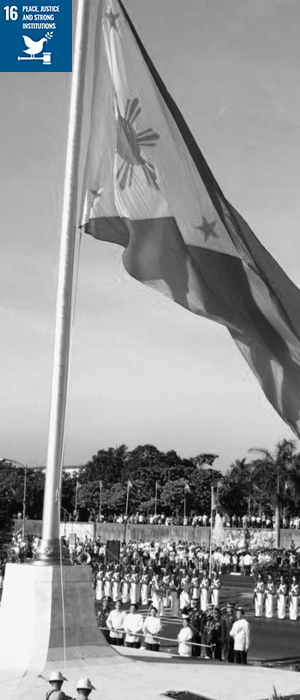 1. Voluntary Local Review (VLR) of SDGs in Naga City, Camarines Sur
1. Voluntary Local Review (VLR) of SDGs in Naga City, Camarines Sur
SDG Target Addressed:
Goal 4 (Quality Education);
Goal 8 (Decent Work and Economic Growth);
Goal 10 (Reduced Inequalities);
Goal 13 (Climate Action); and
Goal 16 (Peace, Justice and Strong Institutions).
Description: The project entitled, “Voluntary Local Review (VLR) of SDGs in Naga City Camarines Sur” aims to enable the city government to listen to people’s needs and reflect them into local policymaking; to promote local self-reflection by diagnosing the state of local development and identifying pathways for better localization of the SDGs; To jumpstart and institutionalize a process that us data-driven, which can be used for local action planning and budgeting; and to share Naga City’s experience in localizing the SDGs and measuring their progress in the city as its contribution to the global conversation on sustainable development.
2. Great Women Project 2
SDG Target Addressed:
Goal 5 (Gender Equality)
– 5.5 Ensure women’s full and effective participation and equal opportunities for leadership at all levels of decision-making in political, economic, and public life
– 5.5.2 Proportion of women in managerial positions
– 5.5s1 Percentage of firms owned by women (through business permits and licenses systems)
Description: The “Great Woman Project” or GWP2 which is also known as Supporting Women’s Economic Empowerment (WEE) in the Philippines, is funded by the Canadian government amounting to PHP 334.9-million. This project was developed to contribute to job generation and inclusive growth by improving the economic empowerment of women micro entrepreneurs (WMEs), and enhancing the enabling environment for women’s economic empowerment; to improve competitiveness and sustainability of women’s enterprises in order to produce quality, environment for women’s economic empowerment; To enhance entrepreneurial capacity and continuous improvement of environmental policy; and To assess the impact of the project to the enrolled WMEs both as women and entrepreneurs. The budget allocation for this project is PHP 1,130,405.40. For the achievements to date; 10 out of the 52 enrolled WMEs received technical assistance on certification registration; 16 out of 52 enrolled WMEs attended product development sessions and received semi-expendable equipment; and 17 out of 52 enrollees expanded their market through digital/online trade fairs. 96 percent of women who received training rated the quality and usefulness of training as Very Satisfactory. The result shows that the participants’ expectations were met and they were very satisfied with the general outcome of the activity.
3. Small Enterprise Technology Upgrading Program (SETUP)
SDG Target Addressed:
Goal 9 (Industry, Innovation, Infrastructure)
– 9.5 Enhance scientific research, upgrade the technological capacities of industrial sectors in all countries, in particular developing countries, including by 2030, encouraging innovation and substantially increasing the number of research and development (R&D) workers per 1 million people and public and private R&D spending.
– 9.5.1 R&D expenditure as a proportion of GDP
Description: The Small Enterprise Technology Upgrading Program (SETUP) is the prime target for reaching out to Filipino MSMEs in the Bicol Region. SETUP provides MSMEs with equipment and technical assistance in order for them to increase sales and production, streamline and improve overall company operations, upgrade product and service quality, conform to national and international standards of excellence, and compete in their respective fields. The objective of this project is to alleviate poverty by encouraging and assisting MSMEs in developing technological innovations and enhance operational efficiency and boost problems and improve productivity and competitiveness. The target outcome of this project is to increase productivity and employment of the companies and individual firm based in the Philippines and wholly owned by Filipino netizens. For the achievements to date, DOST V released a total of PHP42.5M worth of assistance to 52 project/firms.
4. Bicol Regional Food Innovation and Commercialization Center
SDG Target Addressed:
Goal 9 (Industry, Innovation, Infrastructure)
– 9.5 Enhance scientific research, upgrade the technological capacities of industrial sectors in all countries, in particular developing countries, including by 2030, encouraging innovation and substantially increasing the number of research and development (R&D) workers per 1 million people and public and private R&D spending.
– 9.5.1 R&D expenditure as a proportion of GDP
Description: This project is part of DOST’s “HITS: Roll-out of the DOST-developed Food Processing Equipment to the Regions” in partnership with the Bicol University. The center encourages product innovation and provides opportunities for commercialization to Micro, Small, and Medium Enterprises (MSME) and farmer-producers. It serves as an incubation area that will create and test new products, from conceptualization to market testing using latest technologies in preparation for the trading in market. The center’s food innovation and commercialization activities focus on the region’s pasalubong food products using indigenous raw materials, nutrition-enhancing food items, disaster-ready food products, and gender-age responsive food items. The goal of this project is to improve the product quality and productivity of food processors in the regions. The target outcome of this project is to increase the number of innovation hub customers/beneficiaries. For the achievements of this event, last December 7 and 9 2021, the 1st Regional Conference on Science and Technology was conducted. Last November 16, 2021, license was granted to operate as a Food Manufacturer by the FDA.
5. Abaca Technology Innovation Center (ATIC)
SDG Target Addressed:
Goal 9 (Industry, Innovation, Infrastructure)
– 9.5 Enhance scientific research, upgrade the technological capacities of industrial sectors in all countries, in particular developing countries, including by 2030, encouraging innovation and substantially increasing the number of research and development (R&D) workers per 1 million people and public and private R&D spending.
– 9.5.1 R&D expenditure as a proportion of GDP
Description: The ATIC was established to investigate industrial, pharmacological, and other nontraditional abaca applications, improve post-harvest facilities/equipment, and produce an abaca information system. This project aims to develop a business incubation hub where researchers, students, industry players and other stakeholders can engage and acquire technologies and information that will provide investment opportunities, education and research and development (R&D) innovations, consequently transforming such knowledge to more and better products and services. It also intends to strengthen the abaca industry through an innovation center that will help in the development of local abaca products.
The target outcome of this project is to increase the number of innovation hub customers/beneficiaries. The achievements of this project are that the SRP abaca paper was granted intellectual property rights by the Intellectual Property Office of the Philippines. The study entitled Abaca Core Wine won as the Outstanding Creative Research (LIKHA) under Government Funded Projects in the recently concluded CY 2021 Pre-NSTW Celebration of DOST V.
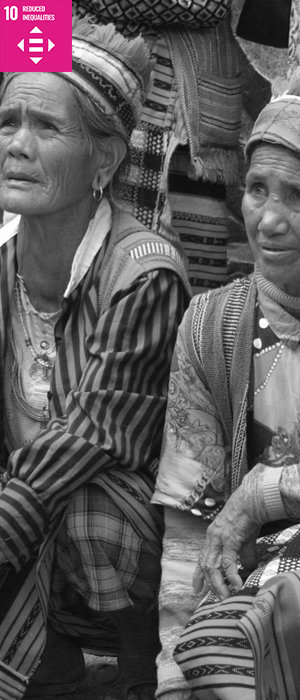 6. Crabmeat Processing and Canning Facility (CPCF)
6. Crabmeat Processing and Canning Facility (CPCF)
SDG Target Addressed:
Goal 9 (Industry, Innovation, Infrastructure)
– 9.5 Enhance scientific research, upgrade the technological capacities of industrial sectors in all countries, in particular developing countries, including by 2030, encouraging innovation and substantially increasing the number of research and development (R&D) workers per 1 million people and public and private R&D spending.
– 9.5.1 R&D expenditure as a proportion of GDP
Description: The CPCF is designed to provide value-adding technologies to maximize economic gains by direct beneficiaries such as crabbers, crabmeat processors, crab pickers, food-based micro, small and medium enterprises (MSMEs) and college students. This project aims to infuse innovative and value-adding technologies to maximize economic gain from available marine resources in the province of Sorsogon vis-à-vis develop more globally competitive products. The target outcome of this project is to increase the number of innovation hub customers/beneficiaries (Crabbers, crabmeat processors, food-based MSMEs, crabmeat pickers, researchers, innovators and students). The achievement of this project is the installation/fabrication of an ice making machine, cold room storage and other equipment for CPCF has started. The processing plant is already energized by the SORECO.
7. Queen Pineapple NICER Project
SDG Target Addressed:
Goal 9 (Industry, Innovation, Infrastructure)
– 9.5 Enhance scientific research, upgrade the technological capacities of industrial sectors in all countries, in particular developing countries, including by 2030, encouraging innovation and substantially increasing the number of research and development (R&D) workers per 1 million people and public and private R&D spending.
– 9.5.1 R&D expenditure as a proportion of GDP
Description: This project aims to improve S&T interventions to enhance productivity and marketability of the Queen Pineapple crop and eventually alleviate the economic situation of producers/farmers in the province. The target outcome of this project is to increase the number of research and development centers. The achievements of this project are the development of a software phone application for pest detection; classification and crop protection management with farmland; pest mapping; and Geotagging and detection of mealybug wilt-associated virus on Queen Pineapple using real-time polymerase chain reaction (PCR) Assays.
8. Mapping of Inventory of Government Lands for Resettlement, Housing and Urban Development
SDG Target Addressed:
Goal 11 (Sustainable Cities and Communities)
– 11.1: By 2030, ensure access for all to adequate, safe, and affordable housing and basic services and upgrade slums
Description: Under RA 112021, DHSUD is mandated to develop and maintain an information system which shall include inventory of idle lands, CLUPs, inventory for the effective management and monitoring of land use, zoning, and urban development standards in the Philippines. This project aims to increase collection of land inventories of local government units (LGUs) and provide technical assistance to the LGUs in mapping and validation of land inventory matrices, including other spatial data requirements (ISF) locations as basis for the identification potential sites for resettlement, housing and urban development projects. The target outcome of this project is to enable the Department and LGUs to properly identify and designate suitable lands for housing and urban and rural development to ensure that adequate housing is provided to the Filipino people. The achievement of this project is that last January 14, 2022, 91.25 percent collected inventory of government-owned lands.
Region VII
1. Family Planning Mobile Application
 SDG Target Addressed:
SDG Target Addressed:
Goal 3 (Good Health and Well-being)
– 3.7 Ensure universal access to sexual and reproductive health-care services, including for family planning, information and education, and the integration of reproductive health into national strategies and programs.
Description: The POPCOM Family Planning Mobile Application is a pioneering endeavor of POPCOM Regional Office 7. The objective of this project is to facilitate the recording, reporting, distribution, and monitoring of available family planning (FP) commodities at various sites/outlets for easy access. The POPCOM FP mobile app will be available at play store and can be downloaded for free only for those in the POPCOM VII network with those who are assigned to manage and facilitate the family planning commodities. The target outcome of this project is to Real-time information on available family planning (FP) commodities in nearest locations/ facilities for a faster delivery of family planning service.
Region IX
1. Coastal and Marine Ecosystems Management Program (CMEMP)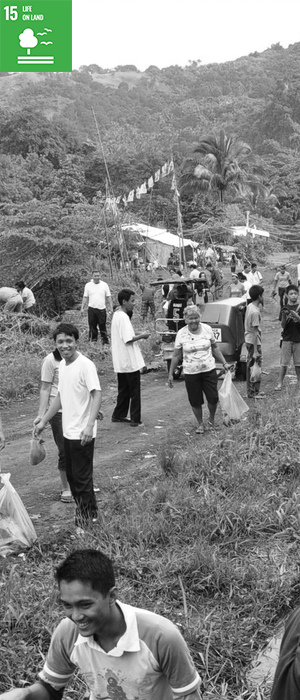
SDGs Addressed:
Goal 14 (Life Below Water)
Description: The Coastal and Marine Ecosystems Management Program (CMEMP) is a national program which aims to comprehensively manage, address and effectively reduce the drivers and threats of degradation of the coastal and marine ecosystems in order to achieve and promote sustainability of ecosystem services, food security and climate change resiliency for the benefit of the present and future generations. Under the CMEMP, protection and management shall be anchored on the following approaches: (a) Integrated Coastal Management, (b) Partnership Building, (c) Ecotourism/Sustainable Tourism, (d) Protection, Management and Law Enforcement, (e) Communication, Education and Public Awareness, and (f) Valuation of Ecosystems Services.
2. National Greening Program (NGP)
SDGs Addressed:
Goal 1 (No Poverty);
Goal 2 (Zero Hunger); and
Goal 15 (Life on Land)
Description: The National Greening Program (NGP) is a convergence initiative and a government priority to pursue Sustainable Development for Poverty Reduction, Food Security, Biodiversity Conservation and Climate Change Mitigation and Adaptation per Executive Order No. 26 series of 2011. This aims to plant 1.5 Billion trees covering about 1.5 Million hectares of land of the public domain from 2011-2016.
Overall, 118,178 hectares of forest area has been forested from 2011-2016, 27% above the target. Global Forest Resources Assessment for CY 2015, the Food and Agriculture Organization ranked the Philippines as 5th worldwide in the greatest forest area gain from 2010-2015. In order to accelerate the rehabilitation and reforestation of the 7.1 million remaining hectares of unproductive, denuded and degraded forestlands in consistent with the updated Master Plan for Forestry Development (2016-2028), the coverage of National Greening Program is expanded/extended the period of implementation from 2016-2028 per Executive Order No. 193 series of 2015.
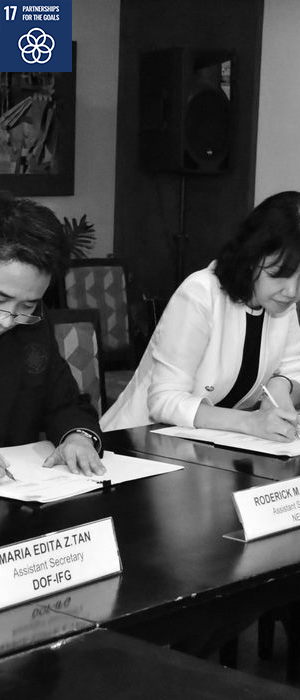 3. Community Empowerment Thru Science and Technology (CEST)
3. Community Empowerment Thru Science and Technology (CEST)
SDGs Addressed:
Not Stated
Description: CEST is a package of S&T interventions which aims to build progressive, empowered and resilient rural communities. CEST was DOST’s response to the National Program on Poverty Alleviation of the government by means of empowering the poor and the marginalized sector and improving the quality of living through science and technology. Packaged S&T interventions are focused on five (5) entry points: Health and Nutrition, Water and Sanitation, Basic Education and Literacy, Economic Enterprise and Development and Disaster Risk Reduction/ Climate Change Mitigation.
After a few years of implementation, the program has empowered and continues empowering Thirty-three (33) communities in Zamboanga Peninsula and most of it are from Marginalized Sectors. The program also expanded or “leveled-up” and now called CEST-UP or the Community Empowerment thru Science and Technology – Upscaling for Progress.
4. Small Enterprise Technology Upgrading Program (SETUP)
SDGs Addressed:
Goal 8 (Decent Work and Economic Growth)
Description: The sustained implementation of Small and Medium Enterprises Technology Upgrading Program (SETUP) as a viable alternative program to effect the growth of micro, small and medium enterprises (MSMEs) in the regions has already earned itself a reputation as an image-enhancing program of the national government. The program has produced phenomenal results in bringing about creativity and innovations to the stakeholders, especially those in the micro and small business circles. The gains over the decade, since its inception in 2002, have also brought about positive change in the outlook and values of most entrepreneurs giving them a sense of self-empowerment. Technology and other knowledge-based activities are viewed by many entrepreneurs as the crucial motivating factors that enable them to recognize their inherent potential capable of surmounting the challenges of business complexity in these highly competitive global markets. While the infusion of resources has somehow contributed to much improvement in the delivery of government services, nevertheless, it is the scientific consciousness or the knowledge culture developed through SETUP that revives the aspirations of most people, especially the MSMEs, to be highly productive.
From January 2020 to December 2021, DOST-IX was able to assist eighty-one (81) MSMEs. Of the 81 projects, 74 were assisted from Q2 2020 to Q4 2021 – during the community quarantine periods. Even in the midst of a pandemic, MSMEs strive to improve their facility and improve their overall production to provide better product and quality service. The total approved funding for these projects amounts to PHP 106,930,202.73 This accounts to 103.28% of the target. Twenty-two (22) of these projects are coming from Zamboanga del Sur, twenty-four (24) from Zamboanga Sibugay, Twenty-five (25) from Zamboanga del Norte and ten (10) from Zamboanga City. These projects include firms from different sectors: 48.15% of these are from the agricultural sector and are mostly rice-related projects; 20.99% are from the food processing sector; 13.58% from metals and engineering; 13.58% from ICT. This shows that not only those that are considered essential (agriculture and food processing sectors) are improving in this challenging time.
Assisted SETUP partners evidently improved their production facilities as well as capacities. In 2020, the program was able to generate 849 jobs and 489 jobs in 2021 – creating opportunities for the people in the locality. The total gross sales generated amounted to a total of PhP 654 million which shows that the firms greatly benefited from the program and have contributed to the economy.
5. Sustainable Development Intervention Program (SDIP)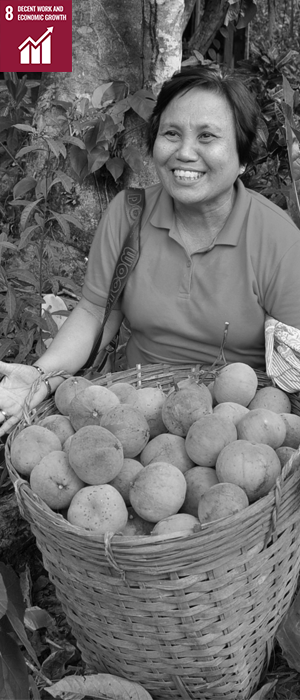
SDGs Addressed:
Goal 1 (No Poverty);
Goal 2 (Zero Hunger); and
Goal 8 (Decent Work and Economic Growth).
Description: SDIP is the after-care program initiated by TEDA RO IX under the Poverty Reduction, Livelihood and Employment Cluster (PRLEC) for the PRLEC Member-Agencies which aims to develop self-reliant, resilient, productive and sustainable communities through harmonized and culturally responsive development programs. This program is in partnership with the Local Government Units of the priority barangays under the Priority Barangay Development Program. As of December 2021, over 964 beneficiaries have benefitted from this program under 34 target barangays in Region IX, benefitting in trade such as Automotive Servicing, Motorcycle/Small Engine Servicing, Food Processing, Masonry, Organic Agriculture, Carpentry, Plumbing, Pastry Production, etc.
6. Mobilizing and Upskilling JUANAs for Economic Resiliency (MUJER)
SDGs addressed:
Goal 5 (Gender Equality);
Goal 8 (Decent Work and Economic Growth); and
Goal 10 (Reducing Inequalities).
Description: MUJER includes a series of training sessions for the economically displaced women of Barangay Baliwasan, which is in line with the GAD mandate, to give opportunity for women in the barangay to learn additional skills that can be used for income generation and self- employment. MUJER is also anchored on ZPPSU Extension Agendum – Skills Capacitating/Competency Upgrade for Local and Overseas Employment (SCCULOE). The approach to be used is stewardship. The stewarding interventions of the community or Steward-Barangay strategic initiative will be focused on generating outcomes and impacts which necessarily must be changes in mindset, values system, capability to earn a living and civic consciousness. Overall, the project aims to (1) mobilize economically displaced women in Barangay Baliwasan for a livelihood training program; and (2) transfer knowledge, and competencies of healthy food production. Under Project MUJER, there was a series of training conducted such as the GAD Capacity Building, Pastry Production, and the Seminar on Financial Literacy and Basic Sales and Marketing.
Region X
 1. Provincial Livelihood Program – Corn Seeds and Fertilizer Distribution Program
1. Provincial Livelihood Program – Corn Seeds and Fertilizer Distribution Program
SDG Addressed:
Goal 1 (No Poverty); and
Goal 2 (Zero Hunger).
Description: The Province of Bukidnon has been very serious in combating the high poverty incidence of the province. As a result, poverty incidence dropped from 54.1% in 2015 to 32.1% in 2018, a massive drop of 22.08%. From being ranked number 6th poorest province, it dropped to Number 19 (PSA, 2019). One of the factors contributing to the massive drop of poverty incidence is the Provincial Livelihood Program which aims to assist the poorest among the poor farmers in the province. The program has been implemented for the past 5 successive years and project outcome is now visible by the decreasing poverty incidence. However, the 32.1% of the population who are still poor is nevertheless still quite high. Thus, the Provincial Government of Bukidnon will continue to implement various livelihood projects to further decrease the current poverty incidence.
2. Marine Protected Area (MPA) Management, Strengthening and Networking under Coastal and Marine Ecosystems Management Program (CMEMP)
SDG Addressed:
Goal 14 (Life Below Water)
Description: The Camiguin-wide MPAN is located in the Province of Camiguin in Mindanao composed of 31 locally-managed MPAs with a total area of 308.29 hectares distributed in five municipalities, namely Mambajao, Mahinog, Guinsiliban, Sagay, and Catarman. The established Camiguin MPAN was initiated through the implementation of the Camiguin Coastal Resource Management Project (CCRMP) in 2008-2013. During this time, an MPA Network Management Committee and Technical Working Group per Municipality were organized. When the CCRMP ended in 2013, the said Committee had slowed down due to lack of sustainable funds to undertake the management meetings for MPAN. But with the implementation of the CMEMP pursuant to DENR Administrative Order No. 2016-26, the DENR pushed for the formal creation of the MPAN through a Memorandum of Agreement (MOA) governed by a Management Body/Technical Working Group The MPAN strives to harmonize policies and strategies for the effective management of the locally-managed MPAs in the Camiguin Province and promote conservation and protection of critical marine habitats to support marine biodiversity, fishery productivity and inclusive economic growth for the Camiguin and the entire Region X. Moreover, this MPAN serves as a tool to achieve the AmBisyon Natin 2040 and SDGs life below water (Goal 14) and no poverty (Goal 1).
3. National Greening Program (NGP)
SDG Addressed:
Goal 1 (No Poverty);
Goal 8 (Decent Work and Economic Growth);
Goal 13 (Climate Action); and
Goal 15 (Life on Land).
Description: The National Greening Program or the NGP is a banner program of DENR. It is a convergence initiative of DA-DAR-DENR where the DENR stands as the lead agency pursuant to EO Nos. 23 and 26, both series of 2011. It was issued to plant 1.5 billion trees in 1.5 million hectares of lands of the public domain for a period of six (6) years from CY 2011 to CY 2016. In 2015, Executive Order No. 193 was signed to expand the program that will rehabilitate all the remaining unproductive, denuded and degraded forestlands estimated at 7.1 million hectares from 2016 to 2028. For Region X, a total of 128,467.57 hectares of denuded forest areas have been rehabilitated under the said program with 2,241 People’s Organizations benefited from 2011-2021.
4. Curriculum Management Support System
SDG Addressed:
Goal 4 (Quality Education)
Description: With the continuing threats of the COVID-19 pandemic and the unprecedented challenges to education, teachers and parents must adapt to alternative learning modalities to ensure that learners achieve essential curricular goals. Hence, the Regional Office (RO), through the Curriculum Learning and Management Division (CLMD), initiated the Curriculum Management Support System (CMSS). CMSS is an online monitoring of schools’ compliance with DO 31, s. 2020 and of the learners’ performance per quarter for all the learning areas from Kindergarten to Senior High School. The schools, with the assistance the SDOs, are required to input the learners’ performance in all the subject areas from regular to special curricular programs implemented in each school two weeks after the end of the quarter.
5. Support in the Establishment of Materials Recovery Facility (MRF) and Solid Waste Management (SWM) Equipment
SDG Addressed:
SDG 11 (Sustainable Cities and Communities); and
Goal 12 (Responsible Consumption and Production).
Description: The technical assistance to LGUs provision of MRF and SWM equipment is to achieve the reduction of the amount of solid waste disposed of to the sanitary landfill as the final disposal facility. Recyclable wastes are brought to MRF for final sorting and stored separately at the facility according to type i.e. paper, plastics, metal, etc. until sold to junk dealers or recyclers. It is also a place where processing biodegradable wastes into compost or organic fertilizer. A materials recovery facility (MRF) is a place where collected segregated wastes are brought to reduce the amount of solid waste through recycling, composting and residual treatment. For CY 2020, a total of 35 SWM equipment were distributed to 31 LGUs and 4 Provinces. For the 31 LGUs, the given equipment was composed of Biodegradable shredder and composter while the Plastic Chair Factory set was installed at the 4 Provinces. For CY 2021, a total of 24 SWM equipment were installed to the different LGUs. The equipment is composed of Biowaste shredders, Biodegradable composters, and Solar Powered 4G Network Camera kit.
6. Vulnerability Risk Assessment
SDG Addressed:
Goal 9 (Industry, Innovation, and Infrastructure); and
Goal 11 (Sustainable Cities and Communities)
Description: This mainly focused on the identification of population centers and inventory of critical infrastructures such as road networks, bridges, airports, schools, hospitals, evacuation centers, police stations, power stations, lifelines and other critical facilities. Aside from data from the field, secondary data from several sources such as the Philippine Statistics Authority (PSA), Municipal Planning and Development Offices (MPDO) of the surveyed areas, Local Disaster Risk Reduction and Management Offices, and Mines and Geosciences Bureau were used in GIS processing to produce risk exposure maps.
7. Key Chain Project
SDG Addressed:
Not Stated
Description: Police Regional Office 10 formulated an operation on “Intensified Campaign on Crime Reporting” with the strategy of using keychain. The Key Chain contains Hotline Numbers of Police Regional Office 10 for easy communication on crime reporting, queries, comments, suggestions and any public opinion. This is usually distributed to schools, markets, bus terminals, plazas and other public places.
The project aids in reporting crime-related activities or any opinions that the public wanted to raise and know. This project may also help neutralize wanted persons who are hiding in remote areas in order that they may be bound to answer in the commission of an offense. Police Regional Office 10 came up with this project because a keychain is useful and handy.
A total of 64,222 activities were conducted in this PRO and distributed 342,968 Key Chains from its implementation up to present. It clearly shows that the continuous distribution of this initiative has a big contribution especially in crime prevention and solution and appreciated by the community since it adapts the modern way of disseminating information (hotline numbers in a keychain) and encourages them to call in case of emergency, for crime reporting, queries, comments, suggestions and any public opinion.
Region XI
1. National Greening Program
SDGs Addressed:
Goal 1 (No Poverty);
Goal 13 (Climate Action); and
Goal 15 (Life on Land).
Description: The Barangay Langtud Farmers Association of Laak Inc. (BALAFALI) was originally a Barangay-based association formed and was formally organized and registered under Securities and Exchange Commission (SEC) no. CN2011331204 on August 30, 2013 through the initiative of Mr. Roberto Sutino Jr. The initial capital builds up was only Php. 7,500.00 contributed by its 15 members. The said amount was the seed money of the association to pursue their vision, mission, goals and objectives of BALAFALI as fondly called by all members. The ultimate objective is to alleviate both the socio-economic and agricultural production of Barangay Langtud in order for the association to become one of the competitive players in the Municipality of Laak through association.
The organization ensures its members security of tenure by having/holding a CSCs over the land they owned and having the privilege to occupy, develop and reside peacefully therein. A total of 77 issued Certificate of Stewardship Contract with a total area of 330.7 hectares and they also have 15 active members of Barangay Langtud Farmers Association of Laak Inc. (BALAFALI). However, timberland area with an approximate of 1.221.83 hectares covered with Certificate of Ancestral Domain Title No.CADI R11-LAA-1005-35; communally owned by the Dibabawon Tribes of Laak which tenurial instrument issued by the National Commission on Indigenous People (NCIP) and approved on October 22, 2005 that this area are potential for development of agroforestry and reforestation program.
Seemingly with the full support of the Po officials and in close collaboration of Barangay BLGU to address their objectives of ecological and environmental concerns were the beginning to be made possible despite of some limitations in the actual field implementation considering of many factors such as unstable peace and order situation and the complex behavior or Bahala Na attitude of project beneficiaries in the area. The positive impacts were made through constant IEC, livelihood training seminars, consultations, transparency with PO cooperative, Barangay LGU and having good relations which have gained positive support to the community.
Lastly in CY 2021, the association was awarded as one of the best ENGP implementers. With this, the National Greening Program (GP) had greater impact to change in the said locality. It is hope that government agencies will
continue to give projects especially on environmental aspects to the project beneficiaries to meet their demand of marginalized upland dwellers who for a long time needs government interventions.
2. Supporting Women’s Economic Empowerment in the Philippines Project or GREAT Women Project 2 (GWP2)
SDG Addressed:
Goal 1 (No Poverty);
Goal 5 (Gender Equality); and
Goal 10 (Sustainable Cities and Communities).
Description: The GREAT Women Project 2 is a governance and capacity development project that aims to contribute to jobs generation and inclusive growth by 1) improving competitiveness and sustainability of women’s micro enterprises, and (2) enhancing the enabling environment for women’s economic empowerment. It is funded by the Government of Canada through Global Affairs Canada (GAC). The Philippine Commission on Women (PCW) serves as the lead executing agency for the project with the Department of Trade and industry (DTI), Department of Agriculture (DA), and Department of Science and Technology (DOST) as its implementing partners. In Region 11, the project also engages with private sector partners namely Bayan Academy, ECHOsi Foundation, and National Confederation of Cooperatives (NATCCO). There are a total of 129 WME beneficiaries in Davao region enrolled through DTI-11(43), DOST-11 (61), DA-11 (24), and ECHOsi Foundation (1). The expected duration of the project was from 2015-2020. But its first full year of implementation for DTI-XI only started in 2017. While the project was originally designed to end in 2020, a 1-year project extension was approved due to COVID-19 global pandemic, hence project implementation officially concluded last December 31, 2021.
3. DavNor Kaagapay Project
SDG Addressed:
Goal 1 (No Poverty);
Goal 2 (Zero Hunger);
Goal 8 (Decent Work and Economic Growth); and
Goal 16 (Peace, Justice, and Strong Institutions).
Description: The Provincial Government of Davao del Norte has been implementing its food security program to prevent food hunger and disruption of social order among residents through DavNor KAAGAPAY dubbed as “KAwsa sa AGrikulturA ug Pangabuhian sa BarangaY” a social and livelihood measures in addressing the adverse effects of Coronavirus Disease (COVID-19) pandemic. Specifically, this program aims to promote food sufficiency, ensure market and peace and harmony in the community among constituents of Davao del Norte. The program was launched on June 17, 2020 and comprises three sectors- Vegetable Production Project, Poultry Production Project and Regreening Project.
In Kaagapay Vegetable Production Project, as of December 2021, a total of 309,360 kilos or 309 metric tons of vegetable produce were tallied during the conduct of Kaagapay Vegetable Field Evaluation last September to November of the same year. The said accomplishment on Kaagapay Vegetable Project revealed 36% increase in production compared to 2020, which is equivalent to a total of 3.3 Million estimated value of vegetable yield, this shows 60% increase compared to last 2020. The data gathered were meticulously tallied by the Provincial Agriculture’s Office based on the submitted monthly reports of the Kaagapay staff who are designated to monitor the vegetable farms within their area of responsibility.
In the Kaagapay Poultry Production Project, the government has helped more people by giving them this livelihood project specially designed to all aspiring Kaagapay beneficiaries who are only interested in animal production. The inclusion of this project are; provision of free-range chickens, feed components, trichanthera seedlings, and free medication and treatments of the chickens dispersed to every POs. All 11 LGUs in the province of Davao del Norte have joined the Kaagapay Program. The LGU of the Island Garden City of Samal has the least number of members with 562 beneficiaries and 29 People’s Organizations created. On the other hand, the LGU of Talaingod has the most number of members with 877 beneficiaries and 36 People’s Organizations formed. There is a total membership of 7,540 beneficiaries and 350 People’s Organization created province-wide. A total of 37,700 chickens dispersed across Davao del Norte. Aside from the benefits that these beneficiaries are getting from the project, they also received an additional cash incentive of Php 3,960 each. TUPAD (TUlong PAnghanapbuhay para sa Ating Disadvantaged/Displaced Workers) is a program of the Department of Labor and Employment that provides financial assistance to partner beneficiaries of Kaagapay Program. In total, there have been Php 33,042,240.00 TUPAD funds disbursed to all the Kaagapay Poultry Project beneficiaries.
Region XII
1. COVID-19 Adjustment Measures Program (CAMP) 1 and 2
SDG Addressed:
Goal 8 (Decent Work and Economic Growth)
Description: The CAMP is a safety net program that offers financial support and employment facilitation to affected workers in private establishments that have adopted Flexible Work Arrangements (FWAs) or temporary closure during the COVID-19 pandemic or generally been affected by the COVID-19 pandemic from its onset in January 2020 until the lifting of the Stringent Social Distancing Measures. For financial support, this program shall provide affected workers with financial relief necessary to mitigate the immediate adverse economic impacts of the COVID-19 pandemic. Meanwhile, for employment facilitation, assistance is to provide affected workers access to available job opportunities suitable to their qualifications through job matching, referral and placement services either for local or overseas employment, employment coaching, and labor market information.
2. Digital Jobs PH Training
SDG Addressed:
Goals 17 (Partnerships for the Goals)
Description: To be able to help address unemployment in the country and support more Filipinos in the countryside gain employment through the online freelancing industry, the DICT is implementing the Digital Jobs PH Training Project. The training primarily aims to increase people’s hireability by focusing on development and improvement of their ICT skills and utilize it for employment opportunities. The scholars are expected to be utilized with the necessary ICT Skills for online freelancing and so far, the program has achieved 54 graduates from 3 Digital Jobs PH Trainings.
3. Plantation Establishment
SDG Addressed:
Goal 15 (Life on Land)
Description: To address the challenges of alleviating the adverse effects of climate change through adopting strategies for resiliency programs, DENR XII implemented further the Enhanced National Greening Program (eNGP) projects including Plantation Establishment. With the issuance of Executive Order No. 193, the period of implementation was extended from 2016 to 2028 in keeping the commitment on enhancing carbon sink in the world.
DENR XII established 7,216 hectares of plantations under the Enhanced and National Greening Program, of which 932 hectares was under the Central Office Based Bamboo Development Project and 6,284 hectares was under the Regular Target. The four provinces, under the jurisdiction of Region XII, namely Cotabato Province, Sarangani Province, South Cotabato, and Sultan Kudarat, contributed in the attaining of the region’s target. It was accomplished through the active involvement of our partner People’s Organization (POs). Site development activities include strip brushing, hole digging, staking, and hauling of planting materials and planting. To ensure the high rate of survival of the plantation established and to maintain the required stock density of at least 85% of the total number of planted seedlings per hectare/polygon, adequate maintenance and protection activities were employed in the established plantations in CY 2021. The maintenance and protection activities such as strip brushing, ring weeding/cultivation, fertilizer application, replanting of dead spots, geotagging and foot patrolling play a vital role in providing a sustainable environment for growth and survival of planted seedlings. The 7,216 hectares’ plantation established for CY 2021 (regular and CO Based) were 100% maintained and protected.
4. Establishment of TESDA Training Centers
SDG Addressed:
Goal 1 (No Poverty);
Goal 2 (Zero Hunger);
Goal 4 (Quality Education); and
Goal 17 (Partnerships for the Goals).
Description: As stipulated under RA 7796 (TESDA Act 1994) to provide relevant, accessible, high quality and efficient technical education and skills development, TESDA fulfills its mandates through providing an avenue for continuous and effective training accessible to communities to cater more individuals from different localities. Hence, the establishment of Provincial Training Centers (PTCs). Moreover, as a directive of Secretary Isidro S. Lapeňa, Ph.D., CSEE, all Provincial Offices are required to have a Provincial Training Center (PTC), in order to further expand the reach and increase the number of TVET beneficiaries. This will enable greater access to quality technical education and skills training for our fellow Filipinos to ultimately achieve a comfortable and brighter future for all, primarily, the residents of the area, with a target of over 18,000 graduates. Seven (7) new training centers have been established, namely: 1. TESDA SOCCSKSARGEN Manpower Development Center 2. PTC Malapatan 3. TTC General Santos City 4. PTC Surallah 5. PTC Lambayong 6. PTC Kidapawan 7. PTC Pigcawayan.
